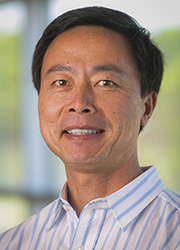Stem cell expert: Bart Starr treatment shows need for rigorous trials in U.S.
The news that legendary Green Bay Packer quarterback Bart Starr has undergone stem cell therapy to recover from a stroke has raised the profile for a promising but unproven regenerative treatment intended to replace dead neurons with live ones.
The University of Wisconsin–Madison’s Su-Chun Zhang was the first scientist to isolate neural stem cells from embryonic stem cells and then from other types of all-purpose stem cells. He says medical researchers and the federal government have a responsibility to forge ahead with clinical trials to prove whether and how these flexible cells can replace damaged or dead neural cells caused by spinal cord injury, stroke and Lou Gehrig’s disease (ALS).

Su-Chun Zhang
“We have no effective treatment for stroke,” says Zhang, a medical doctor and Ph.D. researcher at the UW’s Waisman Center. “After a couple of hours, the cells are dead if they don’t have a blood supply. And the brain has a very limited capacity to regenerate, particularly in older patients.”
Embryonic stem cells — the cells that give rise to all body tissues — were first cultured by James Thomson at UW–Madison in 1998. Just three years later — in 2001 — Zhang discovered how to grow neural cells from embryonic stem cells.
Since then, he has been instrumental in differentiating these neural cells into neurons, which carry nerve signals, and glial cells, which keep neurons healthy. UW–Madison currently has more than 90 faculty working on the basic science and regenerative potential of stem cells. UW scientists publish more than 500 research articles each year on stem cells.
Zhang expressed hope that Starr will recover, but says there are plenty of question marks, such as what type of cells were used, and how they were inserted into the body.
In a statement Wednesday, Starr’s family announced he was participating in a stem-cell trial but gave no details of how or where he was being treated. Published reports have said that the family received information about stem-cell treatment in Tijuana, Mexico, undergone by hockey Hall-of-Famer Gordie Howe.
The Food and Drug Administration has been more conservative than some foreign regulators, Zhang says, but science has advanced to the point where human trials are justified, especially for untreatable conditions.
Given the lack of available therapies for stroke in the U.S., treatments and trials outside the country can understandably appeal to patients and families searching for help.
But Zhang says there are questions about whether foreign trials meaningfully advance the science of the field. Curious about the widespread clinical trials for stem cell therapy said to be underway, he says he “went through lists of thousands of clinical trials, mostly in foreign countries, looking for the outcomes, and I hardly saw any posted results.” Patients usually disappear after returning home, he says, “and many of these so-called trials are not really trials, where you follow the patient and set up standards to measure the outcome. What do they teach you?”
The Food and Drug Administration has been more conservative than some foreign regulators, Zhang says, but science has advanced to the point where human trials are justified, especially for untreatable conditions. “It is time. Many of the procedures are reasonably safe, and stem cell biology has advanced to the point where we can produce highly differentiated cells that are effective in animals. Patients with ALS, spinal cord injury and stroke are desperate.”
Stem cells come in many varieties, Zhang says. “You need a different kind of stem cell for stroke or spinal cord injury.”
“It is time. … Patients with ALS, spinal cord injury and stroke are desperate.”
Su-Chun Zhang
As his interests have shifted from pioneering the basic science of stem cells to their application to relieve suffering, Zhang has proposed building a master neural cell bank and initiating clinical trials. “We are at the point where I feel much more confident about the cells and the procedures. If we are careful and follow the rules set by the FDA, we can do a good job. It may take a few more years, but we are really getting close.”
“We wish Bart Starr all the best,” says Jordana Lenon, spokeswoman for the University of Wisconsin–Madison Stem Cell and Regenerative Medicine Center. The center refers patients considering stem cell treatment to a list of essential questions at the International Society for Stem Cell Research.
“The federal government maintains clinicaltrials.gov as a resource for doctors and patients considering a trial,” Lenon says. “These trials are the only reliable way to get peer-reviewed, publishable clinical research results and attain FDA approval for new treatments so they can truly benefit patients. In the quest for a cure, we need to rely on science. There is no other way.”
Tags: research, stem cells




